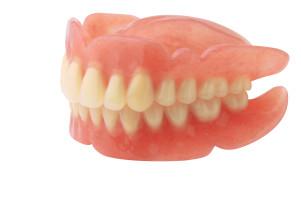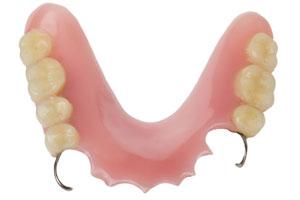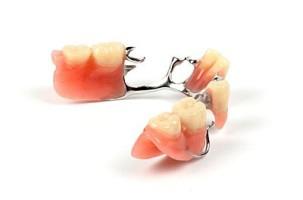Dentures are one option for replacing missing teeth; some of the others include fixed bridgework and dental implants. Each method has its particular pluses and minuses, which should be carefully considered.
Type of denture (The best option for you will depend on your individual situation)
Full denture
Immediate Dentures: These are usually a temporary means of helping you transition to successful denture wearing. The dentures which are placed immediately after tooth extraction won’t fit as well as permanent dentures made when the healing is complete. They do, however, provide you with new teeth right away, and give you time to adjust.

Conventional Full Dentures: After a period of time, permanent dentures that conform to your mouth with near-perfect accuracy can be fabricated. These are carefully crafted to look as much like your own natural teeth as possible, and are able to function properly in your mouth for a long time.
Implant-Supported Overdentures : To increase the stability of a lower or upper denture, it’s possible for it to be securely anchored using two or more dental implants. The upper jaw requires more implants (generally three or more) than the lower jaw due to a lesser bone density. Many people find this option offers a great balance of comfort, functionality and value.
Partial denture
- Transitional Partial Dentures

These relatively inexpensive removable plastic dentures serve as a temporary tooth replacement and space maintainer as you wait for your mouth to heal from tooth extraction, for example. Once the healing process is complete, dental implants can be placed.
- Removable Partial Dentures (RPDs)

Usually made of cast vitallium, these well-constructed, metal-based removable partial dentures are much lighter and less obtrusive than those made of plastic. They are a little more expensive than plastic dentures but will fit better.
After getting denture.
At first, wearing dentures may require some getting used to in terms of talking and eating, as the dentures become “balanced” in the space formerly occupied by the teeth. But over time, the muscles, nerves and ligaments of the mouth learn to work in new ways, which allows these functions to occur normally. Dentures also help support the facial skeleton and the soft tissues of the lips and cheeks, which can help create a more youthful appearance.
How long will it take to get used to wearing a denture?
For the first few weeks, your new partial denture may feel awkward or bulky. However, your mouth will eventually become accustomed to wearing it. Inserting and removing the denture will require some practice. Follow all instructions given by your dentist. Your denture should fit into place with relative ease. Never force the partial denture into position by biting down. This could bend or break the clasps.
Caring for Your Removable Partial Denture
Like natural teeth, you must take good care of your removable partial denture. Here are some tips:
- Clean your partial denture each day. Take it out of your mouth and rinse off food particles. Wet the brush and put the denture cleaner on it. Or you can use a little bit of liquid dish soap.
- Brush all of the denture surfaces gently. It is best to use a special brush made for cleaning dentures, but you can use a toothbrush with soft bristles.
- Do not use toothpaste to clean dentures. Some toothpastes have abrasive particles that can damage the denture base and teeth.
- When brushing your partial denture, hold over a folded towel or a sink filled with cool water. Your removable partial denture is very delicate and can break easily.
- Keep your partial denture in water or denture soaking solution when you are not wearing it. Do not let it dry out or it can lose its shape.
- Rinse the partial denture well after using any denture cleanser. It may contain chemicals that should not go in the mouth.
- Look for denture cleansers with the American Dental Association Seal of Acceptance, a symbol of safety and effectiveness.
- Brush your natural teeth with fluoride toothpaste twice each day. Floss or use another between-the-teeth cleaner once a day.
- Take extra care when you clean teeth that fit under the denture’s metal clasps. Your dentist or dental hygienist can show you how to properly brush and clean between the teeth.
- Keep your denture away from curious children and pets when you are not wearing it.
Adjustments and Repairs
As you get older, the fit of your removable partial denture can change. Your jaw bone can shrink, making a space under the denture. Food can get trapped. The denture clasps also may get loose from normal wear.
If your partial denture needs adjusting, do not adjust it yourself. You can harm both the denture and your health. And do not use household glues to repair the partial, because they can have harmful chemicals.
See your dentist as soon as possible if your removable partial denture breaks, cracks or chips or if one of the teeth becomes loose. Also, your partial denture may need to be adjusted if you lose one of the supporting natural teeth. Sometimes dentists can make the repairs, often on the same day. Complex repairs can take longer. The sooner you make an appointment, the sooner you have a well-fitting partial denture again.
Your dentist will tell you how often to go for dental visits. Regular exams and professional cleanings are very important to keep a healthy smile.
Eating and Speaking
When you replace missing teeth, eating is much easier. But it takes practice. Here are some things that can help:
- Begin by eating soft foods cut into small pieces.
- Chew on both sides of the mouth to keep the pressure even.
- Do not eat very sticky or hard foods, and do not chew gum.
If you have missing teeth, wearing a removable partial denture can help you speak more clearly. If you find that some words are hard to say at first, try reading out loud in front of a mirror. With time and practice, you should be able to speak well.








